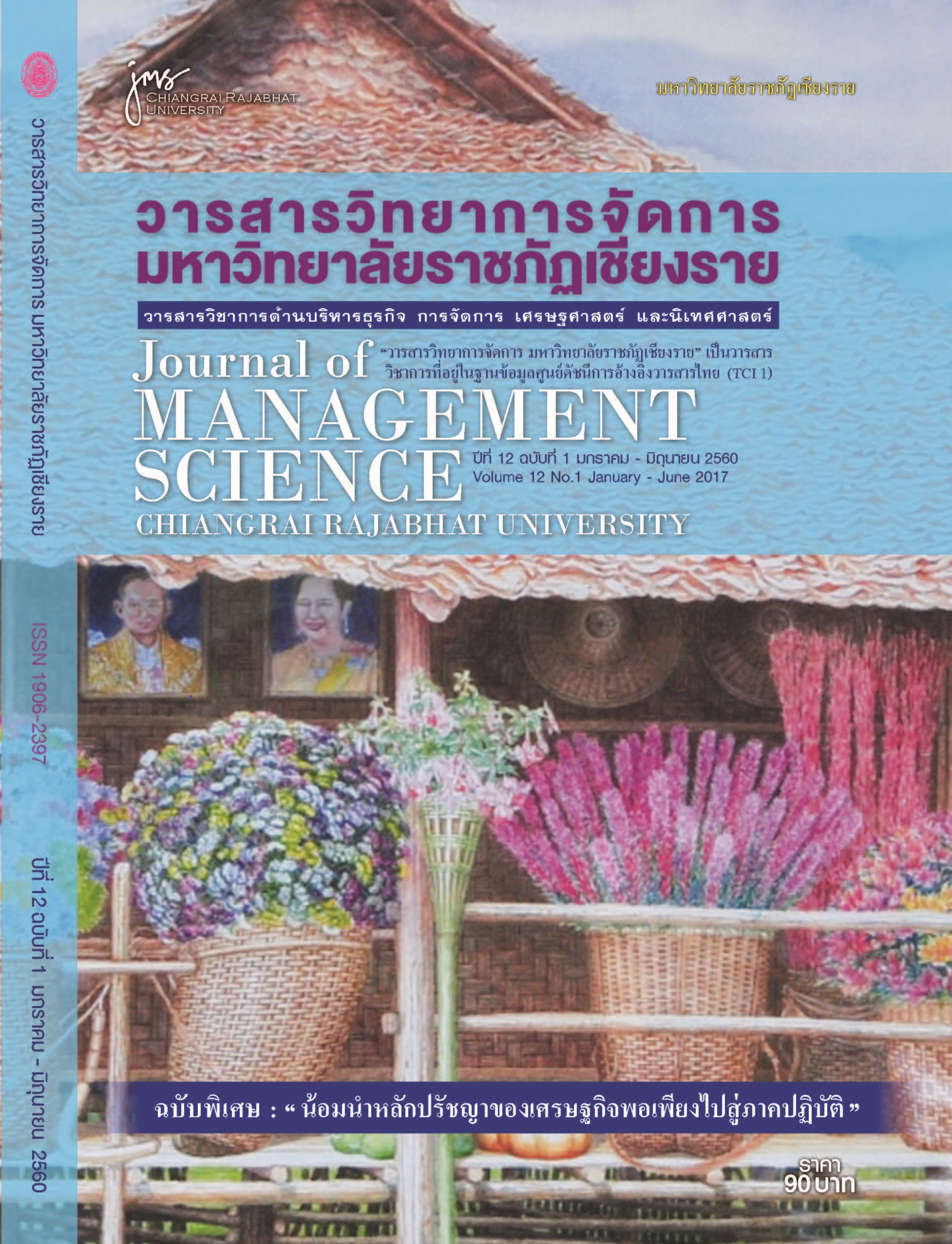The Economic Risk Management Factors of Sufficiency Economy Community, Ban Dok-bua, Phayao Province
Main Article Content
Abstract
The purposes of this research were 1) to study the social and economic structure and the economic risk management of sufficiency economy community in Ban Dok-Bua village, Phayao Province and 2) to find measures and plans to control economic risks of sufficiency economy community in Ban Dok-Bua village, Phayao Province. Questionnaires, interviewing forms and focus group discussion form were used to collect both quantitative and qualitative data from 208 households in the village, including 10 community leaders, 13 chiefs of production groups and concerned officers.
The findings of this research are described as follows:
In terms of the social and economic structure and the economic risk management, twelve risk factors were found and listed as follows: 1) the use of chemicals in agriculture risks for rice and weed control in agricultural plots 2) rice production risks due to lack of knowledge on the management side of the business 3) declination of sufficiency economy inheritors risks caused by children to study and work outside the area 4) the risks of water for agricultural irrigation caused by the catchment area of the community is compromised and natural disasters 5) insufficient knowledge of AEC risks such as foreign languages and cultural traditions 6)the risks of the higher living expenses because of the community lifestyle changes and more consumptions 7) handicraft’s raw materials risks because the handicraft from this community is more accurate 8) homestay management risks to be modern and standard system for tourists. 9) alternative energy risks that it’s not enough with the rising demand 10) waste management risks both from the community itself and tourists who lack awareness of environmental management 11) elderly’s health risks and the number of elderly people increases and 12) the epidemic of illegal drugs risks due to the dynamics of globalization and easier access to various media.
In terms of measures and plans to control economic risks of sufficiency economy community in Ban Dok-Bua village, Phayao Province were found as follows: 1) the preparation of household accounts 2) the measures to increase revenue 3) the guidelines for reducing household expenditures and 4) creating consciousness and inheritance knowledge. Based on the above measures and plans, the sufficiency economy philosophy as a guide to solving problems.
Research recommendations were the community should develop its potentials, focus on Sufficiency Economy, and preserve the knowledges and folk wisdoms. More than that, networking is necessary to knowledge exchange and implementation of joint activities.
Article Details
Views and opinions expressed in the journal do not necessarily reflect those of the editors.
References
ทวีศักดิ์ ชัยปัดถาและคณะ. (2555). บ้านภูชุมชนเศรษฐกิจพอเพียง: สู่การปฏิบัติ. วารสารการบริหารและพัฒนา, 4(3), สืบค้นจาก https://www.tci-thaijo.org.
ธวัชชัย เพ็งพินิจและคณะ. (2554). ตัวชี้วัดความสำเร็จเกษตรพอเพียงของปราชญ์ชาวบ้านและพหุภาคีภาคอีสาน. วารสารวิจัย มสด., 9(1), สืบค้นจาก https://www.tci-thaijo.org.
บริษัท แอดวานซ์ อินโฟร์ เซอร์วิส จำกัด (มหาชน) และ สำนักตรวจสอบภายในและพัฒนาบุคลากร. (2545). Risk Management. กรุงเทพมหานคร.
สมชัย วงษ์นายะและทวนทอง เชาวกีรติพงศ์. (2556). การพัฒนากลยุทธ์การบริหารจัดการหมู่บ้านในการดำเนินชีวิตตามหลักปรัชญาของเศรษฐกิจพอเพียงในจังหวัดกำแพงเพชรและจังหวัดตาก. The golden Teak: Humanity and Social Science Journal, 19(1), สืบค้นจาก https://www.tci-thaijo.org.
สำนักเสริมสร้างความเข้มแข็งชุมชน กรมการพัฒนาชุมชน กระทรวงมหาดไทย. (2554). คู่มือการพัฒนาหมู่บ้านเศรษฐกิจพอเพียงต้นแบบ . กรุงเทพมหานคร.
อเนก ชิตเกษร และพรรณนุช ชัยปินชนะ. โครงการวิจัยและพัฒนาหมู่บ้านเศรษฐกิจพอเพียงให้เป็นแหล่งท่องเที่ยว: กรณีศึกษา บ้านไร่ป่าคา ตำบลท่าตุ้ม อำเภอป่าซาง จังหวัดลำพูน.
อำพน กิตติอำพน (2551). จากปรัชญาของเศรษฐกิจพอเพียง..สู่การปฏิบัติ. (พิมพ์ครั้งที่ 1). กรุงเทพฯ : เพชรรุ่งการ
พิมพ์.


